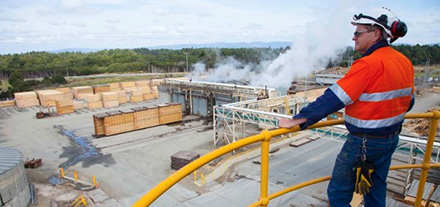Timberlink has committed to reducing greenhouse gas emissions by 21% by 2030. The company’s carbon reduction targets have been verified and approved by the Science Based Target initiative (SBTi). Source: Timberbiz
Using FY18 as a base year Timberlink will commit to reduce scope 1, 2 and 3 greenhouse gas emissions by 21% per m3 of throughput by 2030.
Timberlink further commits to reduce scope 1 and 2 GHG emissions by 53% per m3 of throughput by 2030. The target boundary includes biogenic emissions and removals from bioenergy feedstocks.
“The scope 1 and 2 commitment is aligned with the more ambitious 1.5°C of warming target, rather than the base target of well below 2°C of warming set down in the Paris Agreement, making us a leader in our industry, something which we are very proud of,” Timberlink’s CEO Ian Tyson said.
Greenhouse gas emissions are broken down into three scopes. Scope 1, from direct emissions such as fuel used in forklifts; Scope 2, from indirect emissions from purchased electricity; and Scope 3, from indirect emissions from supply chain sources including log harvest and haulage, downstream haulage and the processing of sold products.
The overall target is to reduce Scope 1, 2 and 3 GHG emissions by 21% per m3 of throughput by 2030. Embedded within that target are a commitment to reduce combined scope 1 and 2 emissions by 53% per m3 and to reduce scope 3 emissions by 20% per m3 throughput by 2030.
Mr Tyson explained that “Timberlink is able to commit to significantly greater reductions in scopes 1 and 2 as they are under our direct control.”
SBTi defines and promotes best practice in science-based target setting and independently assesses and approves companies’ targets. These targets must be aligned with the Paris Agreement, which aims to limit global temperature rise this century to well below 2 degrees Celsius above pre-industrial levels and to pursue efforts to limit the temperature increase even further to 1.5 degrees Celsius.
“This is a significant achievement for Timberlink with the approval of its SBT,” Timberlink’s Chair, David Brand said.
“As a portfolio company of the New Forests’ Australia New Zealand Forest Fund, Timberlink not only leads the way for New Forests’ investments as we work toward SBTs appropriate to the forestry asset class but is showing true industry leadership in how the wood products manufacturing sector can align with the Paris Agreement and deliver on its potential as a key part of a low-carbon economy,” he said.
“Congratulations to the Timberlink team for this accomplishment and all the hard work that went into it.”
The target has been officially endorsed by the SBTi. The SBTi is a collaboration between not-for-profit CDP (Carbon Disclosure Project), the United Nations Global Compact (UNGC), World Resources Institute (WRI), and the Worldwide Fund for Nature (WWF).






